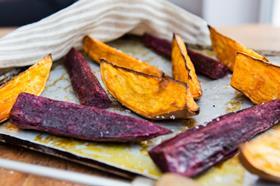
The soaring popularity of sweet potatoes is bringing new players and source countries into the market as growers’ confidence in the long-term prospects for the crop soars.
With celebrities from Alicia Silverstone to Matthew Morrison and Jamie Oliver talking up sweet potatoes in recent years and mainstream marketing campaigns expounding the products’ benefits, it’s been a category on the up and up. In the past year alone, strong double-digit value and volume growth has seen UK retail sales top £57 million and sweet potatoes feature more prominently than ever before on pub and restaurant menus.
Products such as frozen sweet potato fries and wedges, novelty items like sweet potato brownies, and even drinks are adding an extra flourish to a vegetable that is far more versatile than its appearance suggests.
Suppliers are convinced that growth is not about to slow down either. Darren Bevan, commercial director at JDM Food Group, points out that per capita consumption in the US in 2013 was 2.72kg and rising [Statista], compared to 2.15kg in the UK. If this country were to reach US per capital levels, it would mean an extra 37,000t and £44.5m to the market.
“Furthermore, use of sweet potato in sweet dishes is still relatively undiscovered in this country,” Bevan continues. “In addition to this we see growth coming from an expansion of the varieties in the market, and as shoppers begin to understand the cooking and eating properties, then different varieties will be used for different occasions – much the same way that we have seen potato varieties expand.”
Scott Farms believes sweet potatoes’ affirmation as a mainstream line was rubberstamped by the Office for National Statistics including them within its basket of household items, while Jamie Oliver featured them at number four in his top 14 ‘hero foods’.
The company’s own future growth is centred around developing its own branding, according to Stan Smith, chief executive of Scott Farms International. “We’ve always spoken about our drive to consumerise the Scott Farms brand, so that consumers are fully aware of the provenance of our sweet potatoes,” he says. “We’ve had approaches from food producers who use our sweet potatoes in their recipes and want to list on pack the Scott Farms name and Love Sweet Potatoes logo. This is hugely exciting for us and demonstrates that the supply chain is as keen to cite provenance as the consumer is to know the products’ origin.”
On the subject of origin, there is currently plentiful supply on wholesale markets, with product from Spain, Israel and Egypt all in season. “The market is competitive at the moment, with product available from three countries, and all offering smooth-skinned varieties,” says Jacana Produce’s Damian Weedon. “Market conditions are quiet at the moment, but there is plenty of product available, causing prices to be low.”
Countries such as Spain, Portugal and Peru are working hard to establish themselves as prominent players in sweet potato supply, according to Bevan. “Expanding the grower base will bring with it further innovation in varieties, bringing more exciting colours, flavours and shapes of sweet potato to the UK market,” he adds.
As the potential for this burgeoning category continues to rise, one further unexpected new source has come on stream this month – Britain. Watts Farm has produced three tonnes of sweet potatoes at Hill Farm in Farningham, Kent. “Sweet potatoes have been a challenge but we have finally got there after experimenting with a number of different varieties,” group director Joe Cottingham told The Guardian this week, adding that the crop is grown in light soils through a mulch that allows the company to get warmer soil temperatures that produce good-sized potatoes.
It is early days for the British crop, but with demand showing no sign of waning there is clearly the market available for a product that is still very much in theascendancy.
Competing for US trade
US Department of Agriculture data shows that exports of US-grown sweet potatoes have soared from just 16,971 tonnes 10 years ago to 111,660t in 2015 – an increase of 558 per cent. The UK has traditionally been the primary destination, receiving 83 per cent of the volume in 2005. Since then, the European continent has joined the sweet potato parade, bringing the UK’s market share down to 64 per cent.
Innovation alive and well
Sweet potatoes may seem like a difficult sector in which to innovate, but in fact there is a significant amount taking place. In March, for example, Waitrose introduced purple sweet potatoes, which maintain their colour even after cooking. Smaller, roasting sweet potatoes are also making an appearance, while sweet potato crisps are now well established. Growth in the prepared market is being boosted by ready or semi-ready products such as sweet potato mash and wedges.



